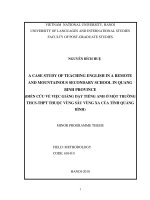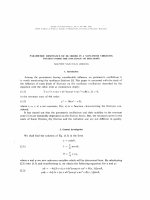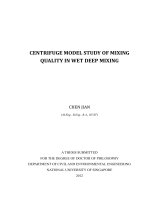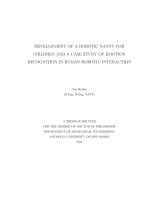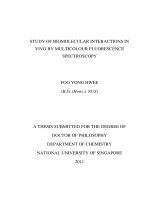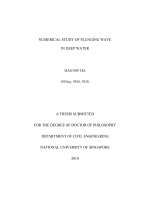Study of microbial count in soil under different land use systems in a mollisol
Bạn đang xem bản rút gọn của tài liệu. Xem và tải ngay bản đầy đủ của tài liệu tại đây (183.37 KB, 6 trang )
Int.J.Curr.Microbiol.App.Sci (2019) 8(1): 16-21
International Journal of Current Microbiology and Applied Sciences
ISSN: 2319-7706 Volume 8 Number 01 (2019)
Journal homepage:
Original Research Article
/>
Study of Microbial Count in Soil under Different
Land Use Systems in a Mollisol
Varsha Pandey*, Poonam Gautam and A.P. Singh
Department of Soil Science, College of Agriculture, G B Pant University of Agriculture and
Technology, Pantnagar 263145, Uttarakhand, India
*Corresponding author
ABSTRACT
Keywords
Microbial, Count,
Land use systems,
Mollisol
Article Info
Accepted:
04 December 2018
Available Online:
10 January 2019
Present study was undertaken to assess the microbial count in soil under different land use
systems in a Mollisol at Norman E. Borlaug Crop Research Centre, G.B. Pant University,
Pantnagar. The land use systems were rice–wheat–green gram, rice–pea (vegetable)-maize,
rice-potato –okra, rice–berseem + oat + mustard (fodder)-maize + cowpea (fodder),
maize–wheat–cowpea, sorghum (fodder)-yellow sarson-black gram, guava + lemon, poplar
+ turmeric, eucalyptus + turmeric and fallow (uncultivated land). Samples were taken from
0-20cm depth and counts of microorganisms were carried out by using serial dilution pour
plate method. Results indicated that soils under agroforestry based systems showed best
results with respect to soil biological health followed by field crops, horticultural crops and
the uncultivated land.
constituents of soil microorganisms, such as
microbial community diversity, have often
been identified as sensitive indicators of
biological indices for maintaining soil health
and quality (Bending et al., 2004).
Introduction
Soil, a part of land, is the most important
production factor for crops and at the same
time influenced most by the farm practices.
There is a considerable decline in soil fertility
because of continuous growing of crops one
after
another
without
giving
much
consideration to the nutrient requirement of
the crops grown (Ghosh et al., 2003).
Microorganisms in the soil strongly influence
soil processes (Garbeva et al., 2004), fulfill
key roles in the decomposition of organic
matter, the cycling of carbon and nitrogen and
the formation and stabilization of soil structure
(Loranger-Merciris et al., 2006). The
The soil microbial diversity is the most
important functional component of the soil
biota (Tate, 2000). Microbial adaptation to
environmental conditions allows microbial
analysis to be discriminating in soil health
assessment, and changes in microbial
populations and activities may therefore
function as an excellent indicator of change in
soil health (Kennedy et al., 1995; Pankhurst et
al., 1995).
16
Int.J.Curr.Microbiol.App.Sci (2019) 8(1): 16-21
Therefore, the present study was undertaken
with the objective of assessment of soil
microbial count under different land use
systems.
population under all other land use systems.
Bacterial population noted under poplar +
turmeric system was significantly higher than
that under rice-potato –okra, rice–wheat–green
gram, rice–berseem + oat + mustard(fodder)maize + cowpea(fodder), sorghum(fodder)yellow
sarson-black
gram,
rice–
pea(vegetable)-maize, maize–wheat–cowpea,
guava + lemon and fallow(uncultivated) land
use system. Bacterial population noted under
maize–wheat–cowpea
system
was
significantly higher than that under guava +
lemon and fallow (uncultivated) land use
system (Table 1).
Materials and Methods
Present study was undertaken at Norman E.
Borlaug Crop Research Centre at Pantnagar in
Mollisol soil. Five composite soil samples (020 cm depth) representing the whole area were
collected randomly from different land use
systems
comprising
of
field
crops,
horticultural crops, agroforestry crops and
fallow (uncultivated land) of the same block
during kharif, 2017-18. Each composite soil
sample was air dried, processed with the help
of pestle and mortar, passed through 2 mm
sieve and used for the analysis of biological
properties.
Several researchers have reported that
microbial diversity in soil is greater under
agroforestry systems due to the effect of trees
and organic matter inputs and also difference
in litter quality, quantity and root exudates.
The availability of carbonaceous materials and
substrates such as amino acids, sugars and
organic acids are important for supplying
energy for the microbial population (Ferreira
et al., 2012).
The count of microorganisms (bacteria, fungi
and actinomycetes) was carried out by using
serial dilution pour plate method (Wollum,
1982).
The data were analysed statistically by using
complete randomized design (C.R.D). The
data collected on different soil properties were
analysed applying ANOVA technique (Pansa
and Sukhatme, 1985). The overall difference
was tested by F test of significance at 5 %
level of probability. In case of significant F
test, C.D. at 5 % was calculated for comparing
treatment means.
Fungal population
Fungal population in soil significantly varied
under different land use systems and ranged
between 1.35 to 4.15 × 105cfug-1soil (Table 1).
Highest fungal population was recorded under
poplar + turmeric and eucalyptus + turmeric
land use system. Fungal population noted
under
rice-potato-okra
system
was
significantly higher than that under rice–
wheat–green gram, rice–berseem + oat +
mustard(fodder)-maize + cowpea (fodder),
sorghum(fodder)-yellow sarson-black gram,
maize–wheat–cowpea, rice–pea (vegetable)maize, guava + lemon and fallow
(uncultivated) land use system (Table 1).
Fungal count recorded under rice–pea
(vegetable)-maize and guava + lemon system
were significantly higher than that under
fallow (uncultivated) land use system.
Results and Discussion
Bacterial population
Bacterial population in soil significantly
differed under different land use systems and
ranged between 1.62 to 4.75 × 108cfu g-1soil
(Table 1). Highest bacterial population was
seen under eucalyptus + turmeric system
which was significantly higher than
17
Int.J.Curr.Microbiol.App.Sci (2019) 8(1): 16-21
Bharadwaj and Omanwar (1992) observed that
increase in the content of macronutrients in
the soil caused increase in the fungal
population. This might be the reason for
higher fungal population under eucalyptus +
turmeric and poplar + turmeric based land use
system.
than that under fallow (uncultivated) land use
system (Table 1).
Among different groups of microbial
population, the population of bacteria was
recorded
maximum
followed
by
actinomycetes followed by fungal population.
Similar order was also observed by
Radhakrishnan et al., (2016) and Nayak
(2017).
Actinomycetes population
Actinomycetes population in soil varied
significantly under different land use systems
and ranged between 1.87 to 4.51 × 106cfu g-1
soil (Table 1). Highest actinomycetes
population in soil was noted under eucalyptus
+ turmeric system which was significantly
higher than population noted under poplar +
turmeric, rice–wheat–green gram, rice–
berseem + oat + mustard (fodder)-maize +
cowpea(fodder), sorghum (fodder)-yellow
sarson-black gram, rice–pea (vegetable)maize, guava + lemon, maize–wheat–cowpea
and fallow (uncultivated) land use system.
Actinomycetes population noted under guava
+ lemon system was significantly higher than
that under fallow (uncultivated) land use
system (Table 1). Higher actinomycetes
population under eucalyptus + turmeric land
use system might be due to higher organic
matter content of the soil and due to organic
matter added to the soil through leaf litter
which serves as a source of energy for
microbial population. Similar results were also
reported by Joshi and Yadav (2005).
Functional groups of microbes
Azotobacter
Azotobacter population in soil significantly
varied under different land use systems and
ranged between 1.25 to 3.99 ×105cfu g-1soil.
The highest population of Azotobacter was
noted under eucalyptus + turmeric land use
system which was significantly higher than that
under rice–wheat–green gram, rice-potato –
okra, sorghum (fodder)-yellow sarson-black
gram, rice–pea (vegetable)-maize, rice–
berseem + oat + mustard (fodder)-maize +
cowpea (fodder), maize–wheat–cowpea, guava
+ lemon and fallow (uncultivated) land use
system. Azotobacter population observed
recorded under guava + lemon system was
significantly higher than that under fallow
(uncultivated) land use system (Table 2).
Higher population of Azotobacter was noted
under eucalyptus + turmeric system followed
by poplar + turmeric as compared to other
systems. This might be due to the high soil
organic carbon content under these systems.
Azotobacter population ranged from 10 ×104
to 13 ×104cfu g-1 soil in rhizospheric soil due
to high organic matter content of the soil
(Maurya et al., 2012).
Total microbial population
Total microbial population in soil significantly
differed under different land use systems and
ranged between 1.64 to 4.80 × 108 cfu g-1soil.
The highest microbial population was noted
under eucalyptus + turmeric system which was
significantly higher than total microbial
population noted under all other land use
systems. Total microbial population noted
under guava + lemon was significantly higher
Phosphorous solubilizing bacteria (PSB)
PSB population in soil significantly differed
under different land use systems and ranged
18
Int.J.Curr.Microbiol.App.Sci (2019) 8(1): 16-21
between 1.63 to 4.13 × 103cfu g-1 soil. Highest
population of PSB was recorded under
eucalyptus + turmeric system which was
significantly higher than that under all other
land use systems.
mustard(fodder)-maize + cowpea(fodder),
rice–wheat–green gram, sorghum(fodder)yellow
sarson-black
gram,
rice–pea
(vegetable)-maize,
maize–wheat–cowpea,
guava + lemon and fallow(uncultivated) land
use system. PSB population observed under
maize–wheat–cowpea
system
was
significantly higher than that under fallow
(uncultivated) land use system (Table 2).
PSB population noted under poplar + turmeric
and rice-potato-okra system was significantly
higher than that under rice–berseem + oat +
Table.1 Bacterial, fungal and actinomycetes population in soil under
different land use systems at 0 – 20 cm depth
Land use systems
Rice – wheat – green gram
Rice – pea (vegetable) –maize
Rice – potato – okra
Rice – berseem + oat + mustard
(fodder) –maize+cowpea (fodder)
Maize – wheat – cowpea
Sorghum (fodder) – yellow sarson
– black gram
Guava + lemon
Poplar + turmeric
Eucalyptus + turmeric
Fallow (uncultivated land)
SEm±
CD at 5%
Bacteria
(×108cfu g-1
soil)
3.46
3.16
4.10
3.42
Fungus
(×105cfu g-1
soil)
3.54
2.47
3.95
2.91
Actinomycetes
(×106cfu g-1 soil)
3.18
2.94
4.41
3.06
Total count
(×108cfu g-1
soil)
3.49
3.19
4.15
3.46
2.94
3.30
2.69
2.72
2.33
3.02
2.97
3.34
2.72
4.46
4.75
1.62
0.06
0.16
2.46
4.15
4.15
1.35
0.06
0.17
2.47
3.27
4.51
1.87
0.05
0.15
2.74
4.50
4.80
1.64
0.06
0.16
Table.2 Azotobacter and phosphate solubilising bacterial count in soil under different land use
systems at 0–20 cm depth
Land use systems
Rice – wheat – green gram
Rice – pea (vegetable) –maize
Rice – potato – okra
Rice – berseem + oat + mustard (fodder) –
maize+cowpea(fodder)
Maize – wheat – cowpea
Sorghum (fodder) – yellow sarson – black gram
Guava + lemon
Poplar + turmeric
Eucalyptus + turmeric
Fallow (uncultivated land)
SEm±
CD at 5%
19
Azotobacter
(×105cfug-1 soil)
3.80
3.01
3.69
2.90
Phosphate solubilising
bacteria (×103 cfu g-1 soil)
3.07
2.69
3.75
3.25
2.65
3.16
2.49
3.94
3.99
1.25
0.06
0.16
2.38
3.04
2.38
3.81
4.13
1.63
0.03
0.10
Int.J.Curr.Microbiol.App.Sci (2019) 8(1): 16-21
PSB population of the soil was reported
higher under systems with more organic
carbon and nitrogen content which might be
possible because organic carbon in soil
supports the growth of phosphate solubilizing
microbes. Similar results were observed by
Vikram et al., (2007) and Venkateswarlu et
al., (1984).
J.D. 2004. Microbial Diversity In: Soil
selection of microbial populations by
plant and soil type and implications for
disease suppressiveness. Annual Review
of Phytopathology. 42:243-270.
Ghosh, P.K., Dayal, D., Mandal, K.G.,
Wanjari, R.H., Hati, K.M., 2003.
Optimization of fertilizer schedules in
fallow and groundnut- based cropping
systems and an assessment of system
sustainability. Field Crops Res. 80, 83–
98.
Joshi P K and Yadav R K., 2005. Effect of
sewage
on
microbiological
and
chemical properties and crop growth in
reclaimed alkali soil. Proceeding of the
International Conference on Soil, Water
and Environment Quality, Issues and
Strategies, January 28 February 1, 2005,
New Delhi.
Kennedy, A. C. and Papendick, R. I. 1995.
Microbial characteristics of soil quality.
Journal of soil and water conservation
May-June:243-248.
Loranger-Merciris, G., Barthes, L., Gastine,
A. and Leadley, P. 2006. Rapid effects
of plant species diversity and identity on
soil
microbial
communities
in
experimental grassland ecosystems. Soil
Biology and Biochemistry. 38:23362343.
Maurya, B.R., Kumar, A. and Singh, V. 2012.
Diversity
of
Azotobacter
and
Azospirillum in Rhizosphere of different
crop rotations in eastern Uttar Pradesh
of India. Res. J. Microbio., 10: 625-630.
Nayak, D.R., Y.J. Babu., and T.K. Adhya,
2007. Long-term application of compost
influences microbial biomass and
enzyme activities in a tropical Aeric
Endoaquept planted to rice under
flooded condition. Soil Biology and
Biochemistry, 39: 1897-1906.
Pankhurst, C. E., Hawke, B. G., McDonald,
H. J., Kirkby, C. A., Buckerfield, J. C.,
Michelsen, P., O'Brien, K. A., Gupta, V.
In conclusion, it is evident from the study that
different land use systems have significant
impact on soil biological health. Soils under
agroforestry based systems showed best
results with respect to soil biological
environment followed by field crops,
horticultural crop and the uncultivated land.
The study indicates that dense cover and high
litter fall in agroforestry systems led to higher
organic matter content in soil which further
favoured the microbial growth. Study may be
helpful in evaluation of soil health and
thereby
enhancing
cropping
system
sustainability.
References
Bending, G.D., Turner, M.K., Rayns, F.,
Marx, M.C., and Wood, M., 2004.
Microbial and biochemical soil quality
indicators and their potential for
differentiating areas under contrasting
agricultural management regimes. Soil
Biology and Biochemistry. 36:17851792.
Bharadwaj Venkatesh and Omanwar, P.K.,
1992. Impact of long-term fertility
treatments on bulk density, water
contents and microbial population of
soil. Journal of the Indian Society of
Soil Science, 40: 553-555.
Ferreira Araujo, A.S., Cavalho Leite, L.F., de
Freitas Iwata, B., de Andrade Lira Jr.,
M., 2012. Microbiological processing in
agroforestry systems. A review. Agron.
Sustain. Dev., 33, 215–226.
Garbeva, P., Van Veen, J.A. and Van Elsas,
20
Int.J.Curr.Microbiol.App.Sci (2019) 8(1): 16-21
V. S. R., and Doube, B. M. (1995).
Evaluation of soil biological properties
as potential bioindicators of soil health.
Australian Journal of Experimental
Agriculture 35:1015-1028.
Panse, V.G. and Sukhatme, P.V. (1985)
Statistical Methods for Agricultural
Workers. Indian Council of Agricultural
Research Publication, 87-89.
Radhakrishnan, S. and Varadharajan, M.
(2016). Status of microbial diversity in
agroforestry systems in Tamil Nadu,
India. Journal Of Basic Microbiology
56, 662–669.
Tate, R.L. (2000) Effects of heavy metal
contamination and remediation on soil
microbial communities in the vicinity of
a
zinc
smelter.
Journal
of
Environmental Quality. 27:609–617.
Venkateswarlu, B., A.V. Rao and P. Raina,
1984. Evaluation
of
phosphorus
solubilization
by
microorganisms
isolated from aridisols. Journal of
Indian Soil science 32: 273-277.
Vikram, A., Alagawadi, Hamzehzarghani, H.
and Krishnaraj, P.U. 2007. Factors
Related to the Occurrence of Phosphate
Solubilizing Bacteria and Their
Isolation in Vertisols. International
Journal of Agricultural Research 2 (7):
571-580.
Wollum, A.G. 1982. Cultural methods for soil
microorganism. In: Methods of Soil
Analysis, Part 2. Chemical and
Microbiological Properties (Page, A.
K., Millar, R. H. and Keeney, D. R.
eds.) Agronomy Monograph No 9,
ASA-SSSA
Publisher,
Madison,
Wisconsin, USA. pp. 781-814.
How to cite this article:
Varsha Pandey, Poonam Gautam and Singh, A.P. 2019. Study of Microbial Count in Soil under
Different Land Use Systems in a Mollisol. Int.J.Curr.Microbiol.App.Sci. 8(01): 16-21.
doi: />
21



